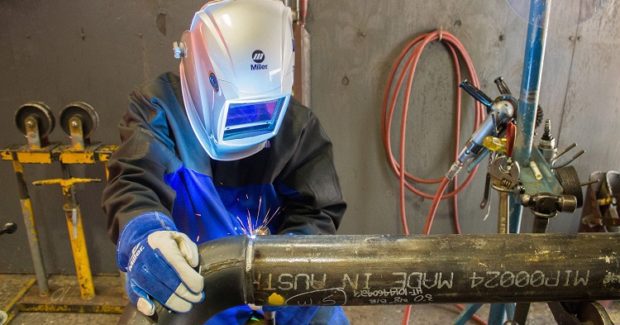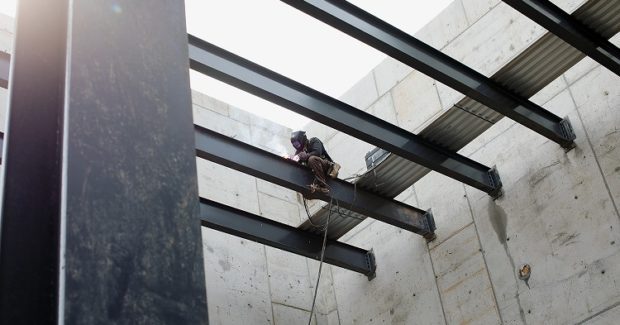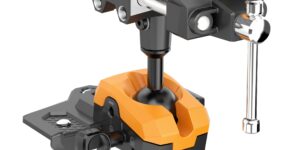To Improve the Bottom Line, Disrupt the Norm
It’s the classic risk/return trade-off: Changing to new welding processes or procedures can be difficult, but the shop that is willing to accept some level of risk can increase their profitability and gain a competitive edge through reduced costs, better quality, improved productivity and shortened project timelines.
Posted: October 4, 2017
Wasted time and lost productivity are enemies in any welding operation. Contractors, manufacturers and fabricators alike are always looking for ways to reduce costs, improve quality and finish projects faster so they can be more competitive. However, the right systems to combat these enemies may require a willingness to disrupt the norm and change to new welding processes or procedures. Making these changes can deliver economic benefits that will help a shop reach their financial goals. Don’t overlook the capabilities that new welding processes and technologies can provide to reduce costs, improve productivity, shorten project timelines or impact quality.
CONSIDER YOUR GOALS
The welding industry is more competitive than ever: The shortage of skilled welding operators is being felt across the industry. Every shop is looking for ways to improve productivity and decrease training time for new welding operators. Even in markets where labor is plentiful, companies push to reduce the time it takes to train a skilled laborer and get them on the job: the faster that workers can be trained, the more productive the operation. On top of this, many shops must adapt their welding operations to changing materials and increasing pressure to meet shorter project timelines. Whatever the challenges, it’s important to determine the key goals in the welding operation. This will help in finding the right systems to deliver the desired results.
Meeting those goals may require changing from standard welding processes to advanced welding systems that offer greater rewards, but may also require additional investment or training. Rather than seeing this change as a risk or a barrier, look at these systems as an investment that can positively impact the bottom line. When it comes time to update the welding fleet, consider how welding technologies have evolved and how newer systems can provide greater efficiencies and savings, rather than continuing to order the same equipment time after time. New welding processes and equipment, filler metals and pre- and post-weld heating techniques can offer competitive advantages above and beyond traditional welding processes and procedures.
A CHANGE TO WELDING PROCESSES CAN DELIVER RESULTS
Many shops have seen significant productivity increases without sacrificing quality by converting from traditional welding processes, such as stick or TIG, to advanced wire processes. Advanced welding processes such as pulsed MIG and Regulated Metal Deposition (RMD®), a modified short-circuit MIG process, offer consistent weld quality and increased productivity through travel speeds that are three times to four times those of stick or TIG. These advanced wire processes are commonly used in the fabrication shop and are now available in machines that are designed to meet the demands of jobsite and field applications.
A modified short-circuit MIG welding process offers easy weld pool control thanks to more forgiveness to variations in stickout and gun angle. This saves time and money by reducing operator training time and delivering quality arc performance that boosts productivity. This process also produces less spatter and allows for the elimination of backing gas. Pulsed MIG offers better fusion and fill at the toes of the weld, higher travel speeds and deposition rates, and shorter changeover time, since the same wire and gas can be used with modified short-circuit MIG processes. Keep in mind the importance of operator training when making these changes and note that a new process may require recertification of new welding procedures.
TECHNOLOGY CAN HELP ADDRESS CHALLENGES
Think about the constant advances in technology in our everyday lives, from televisions to cell phones. Industries are always working to create better and smarter systems, and this is also true for welding, where new technologies are available to improve productivity, quality, power efficiencies, ease of use and portability. For example, new welding power sources can quickly sense and react to what is happening in the weld pool, improving the ability to control the welding current and produce a calm, stable pool with less heat input. Directing the arc energy where it is needed allows both novice and experienced welders to improve their skills. A stable, more consistent arc is also easier to manipulate to ensure good fusion for improved weld quality and less time-consuming and costly rework.
Advanced remote control welding also offers numerous benefits, particularly in jobsite applications. New remote control systems on the market give operators complete control of welding parameters at the weld joint by using the wire feeder or remote, eliminating the need to walk back to the power source to make changes. This means less wasted time and more arc-on time to complete more welds and achieve higher overall productivity. Remote control also reduces trip and fall hazards. Other advances, such as push-button process changeover and digital interfaces, make welding equipment more intuitive and easier to use. This increases productivity by reducing the time spent on machine setup and changeover.
WHAT CAN BE GAINED?
A shop that converts from traditional welding techniques to more advanced systems can realize many financial benefits, including:
- Increased productivity. The financial gains of any productivity improvement vary based on the specific situation, but they can be significant. The return on investment of new machines is shortened through increased productivity and other factors. If an operation is currently operating at or near full capacity at current facilities and is considering a capital expansion, increasing throughput and productivity at those existing facilities could postpone that need. If operations are struggling to find and retain a skilled welding workforce, productivity improvements can help meet demands while utilizing the current workers. If a company operates in or sources fabricated components from regions of the world where labor costs are high, productivity improvements provide a significant cost reduction.
- Reduced scrap loss. This is a key issue in some markets because so much money is lost in scrap. If a shop uses a stick welding process, it’s relatively easy to calculate the potential savings related to reducing the scrap from stub loss (the portion of the electrode that is not able to be deposited in the weld). Because the nature of stick welding produces stub loss, a common goal for welders is to achieve stub loss lengths of 2 in to 3 in. Depending on the original length of the electrode, typically 11 cm to 18 cm, it is easy to figure the “planned scrap” in the stick welding process: generally 16 percent to 25 percent of the electrodes. A change from stick welding to a wire process not only eliminates the costs of this stub loss, it also saves labor through a more productive operation.
- Reduction in failures and rework. Consistent arc performance and filler metal selection are key to achieving higher first-time weld pass rates and fewer weld failures. Welding processes and systems that offer more consistent arc performance can reduce the time and money spent on weld failures and rework. While there is some risk in changing from one welding process to another, advancements in the technologies and filler metals have helped diminish that risk over the years. Quality is obviously an important factor in the success of a welding operation. A high level of rework not only impacts quality, it also delays job delivery because unplanned rework disrupts the entire flow of the manufacturing and/or construction process.
Keep in mind that change can be difficult and it sometimes requires an organized effort. This is the classic risk/return trade-off. Companies that are willing to accept some level of risk can be rewarded with faster project completion, potential cost reductions and a better utilization of assets. To mitigate the risk involved in such a change, proper training programs should be implemented because different welding processes or technologies may operate differently than what a workforce is used to. It is also important to outline a testing plan, when necessary, to ensure that quality and productivity goals are achieved in the welding operation.
THE BOTTOM LINE
In many cases, welding equipment has evolved to provide a level of control that simply wasn’t possible in the past. Welding processes are leaping ahead through technology, and will likely continue to do so in the future. Understanding the potential productivity gains offered by advanced welding processes and new technologies and procedures can help fabricators ensure that their jobs are completed on time and on budget.
Investing in new welding techniques and equipment can help them address critical industry challenges, whether it involves a shortage of skilled welders, shorter project timelines, or changing materials. Being open to changes in the welding operation can reduce costs, improve productivity and shorten training time for welders – and make your company more competitive.












